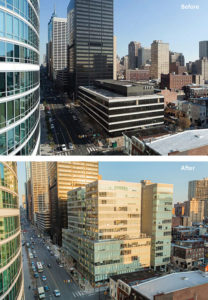Vacant Building Transformed Thanks to Prefab Construction
The Harman Group, Inc. was an Outstanding Award Winner for its 2040 Market Street project in the 2015 NCSEA Annual Excellence in Structural Engineering Awards Program in the Category – Forensic/Renovation/Retrofit/Rehabilitation Structure over $20M.
Originally built in the 1960s, 2040 Market Street was developed as a bustling office building in the heart of Center City, Philadelphia. By the early 2000s, however, the former headquarters of the America Automobile Association (AAA) was felled by the Great Recession, eventually sitting vacant after the travel company relocated in 2005. The once coveted piece of real estate sat empty for several years, a symbol of the downtrodden economy. In 2011, PMC Property Group of Philadelphia acquired and transformed the existing five-story concrete-framed building into luxurious mixed-use residential apartments by expanding both vertically and horizontally.
Structural engineering firm The Harman Group (THG) was tasked with determining how many additional floors could be added to the existing structure. Using a system of load-bearing steel wall panels and an Ecospan floor system, THG added eight residential floors vertically and expanded the building’s horizontal footprint by 68,000 square feet, reaching the same top floor elevation as the overbuild. The vertical and horizontal expansion revamped a 120,000 square- foot vacant office building into more than 300,000 square feet of residential units and ground-level retail space. In total, the new addition used 256 tons of structural steel.
Integrity Max is a simple and effective solution to wall panels. The 11-foot 2½-inch tall panel is constructed with 4-x 4-inch cold-formed tubes supplemented with 4-inch hollow structural section (HSS) members, where required. The interior tube can carry greater loads, without any horizontal bridging, making an open vertical space between studs for mechanical and other systems. These panels also helped minimize the weight of the overbuild portions, while reducing the erection time as well.
Thanks to its lightweight construction, the Ecospan floor system from Nucor-Vulcraft helped maximize the number of floors that could be added to 2040 Market. Ecospan is a composite floor system comprised of a 3½-inch slab on metal deck supported by 12-inch deep open web steel bar joists. The light-weight construction of this system allowed for three more overbuild levels than a traditional steel-framed system would have allowed. This expansion was critical for the Owner, as it enabled them to develop the maximum number of leasable apartments. The floor joists also have a special flush joist seat which allows for uninterrupted bearing through the floor slab from level to level, a critical factor for load transfer.
The existing building is concrete waffle-slab construction with columns spaced 27 feet apart. To minimize cost and depth for the transfer structure between the concrete building and the new steel-framed floors of the overbuild, Integrity Wall prefabricated structural steel in-wall trusses designed to transfer the loads from above. With the combined structure serving as an architectural wall and providing load support, the transfer level structure was reduced to only 10 to 15 pounds per square foot, compared to the 25 pounds per square foot offered by a conventional stick-built structural steel transfer floor. When construction was complete, the transfer trusses “disappeared” within the demising walls.
Securing the overbuild to the existing structure posed some unique challenges. Traditional baseplate and anchor rod tie-down connections to the existing roof slab were not robust enough to resist the high net uplift forces at the interface with the overbuild. Tie-down connections to the existing roof slab proved inadequate. The team decided to bypass the existing roof slab to combat this issue. 1.5-inch diameter anchor rods were installed through holes drilled in the existing roof slab and welded to steel plates with post-installed anchors on all faces of the existing concrete column.
The location of the 13-story horizontal expansion needed to be on top of the single-story basement at the back of the existing building. The existing concrete columns were adequate for the overbuild, but the existing foundation had to be reinforced. Working together with the contractor, THG developed an innovative but simple solution to maximize the height of the horizontal expansion by shoring the existing basement, removing the existing footings and replacing them with larger footings.
Integrity Wall and South Shore Iron Works prefabricated Viernedeel trusses for 2040 Market to act as in-floor girders where the layout required large web openings. The 50 percent open structure provided the ability to pass utilities through congested areas easily. Vierendeel trusses with HSS top and bottom chords and vertical tubes were also used for the exterior. The trusses were installed at each floor below the glazing and erected concurrently with the building to support a Trespa façade.
Today’s construction industry is driven by two elements: time and money. Projects need to be built on a tight schedule and delivered within budget. Prefabricated elements are an effective way to meet these goals without compromising quality. The overbuild of 2040 Market used every imaginable way of prefabricating the steel structure to enable a lightweight overbuild structure that could be constructed quickly at an efficient cost. The result was the transformation of an abandoned eyesore into a glittering new mixed-use residential building in the heart of Philadelphia.▪

